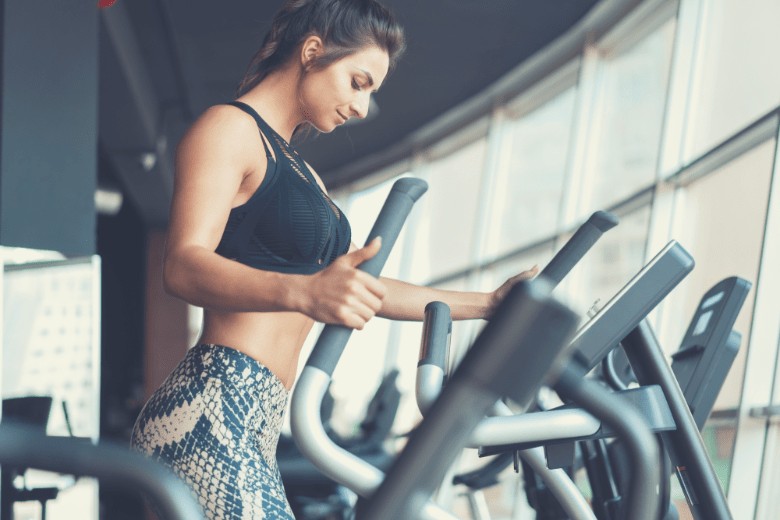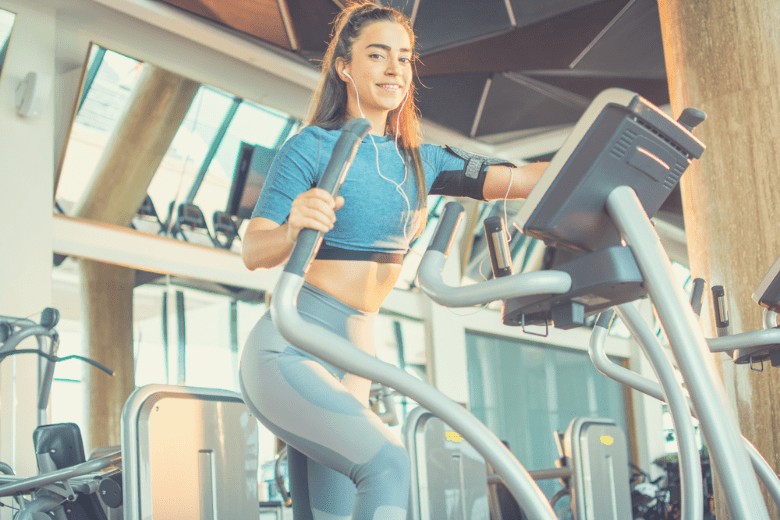You often hear about how cardio is good for you. When you think of cardio, you might think of running or cycling.
However, the elliptical is another great form of cardio.
There are many benefits to it. Now, you might be new to the cardio world or just entered. In that case, you might not know how to use an elliptical.
How do you use one?
Read on to find out why you should use an elliptical and how to use it.
Why Cardio is Beneficial?
Cardio has many benefits for the body. It doesn’t just benefit your physical health but your mental health too.
Studies show that cardio can make you happier.
This happens because it releases “feel good” chemicals like serotonin and dopamine that give you that “runner’s high” feeling.
There are plenty of physical health reasons to do cardio.
Certain types are good for your bones because they put pressure on them which makes them stronger and less susceptible to bone diseases.
Cardio helps regulate your energy levels and sleep.
You’ll have more energy due to the “feel good” chemicals. However, you will find that your sleep improves.
You’ll sleep deeper and less likely to suffer from sleepless nights.
Cardio improves circulation in your body. Your body can deliver oxygen, blood, and nutrients to your muscles faster.
This cuts down on your risk for sicknesses, lowers blood sugar and blood pressure, and reduces the risk of stroke, diabetes, and heart attacks or disease.
Studies have shown it even helps with cognitive decline as you age.
Why Should You Choose the Elliptical?
There are dozens of options for cardio.
You might wonder which type you should focus on. For some, it might depend on what muscle groups you’re focusing on.
While it’s true all types of cardio are beneficial to your health, some types are easier on the body than others or focus on specific areas of the body.
For example, a runner might not have any interest in types that focus more on the upper body.
However, an elliptical workout might interest them since it focuses more on the leg muscles with less stress on the joints.
It also works the upper body if you choose to.
But others might be new to their exercise routine and need to start with an exercise that’s less intense as they work their way up.
On the opposite spectrum, some advanced fitness people might gravitate towards elliptical workouts on recovery days or if they have injuries.
Whichever your reason for using the elliptical machine, you’re sure to reap benefits.
What are the benefits of elliptical machines? Quite a few.
Full-body Workout

Unlike most cardio exercises, they only focus on your upper or lower body. The elliptical works your whole body.
Since you have to work on balancing yourself.
Your core gets a major workout. With or without the handlebars that’s one area you don’t have to worry about.
Your arms and back get a workout when you keep pace with your legs. Of course, your glute, legs, and the muscles around it get a workout too.
Low-impact Exercise
Many people will advocate for running over the elliptical. There’s no doubt running has its perks. However, some people might be better off without it.
Running is a high-impact exercise. These types of exercises can cause “wear and tear” to the body over time.
You are more prone to injuries too. Lower-impact exercises can save your knees, hips, and ankles from damage over time.
Versatile Workout
The elliptical might seem boring. You’re basically striding in place, right? Wrong! There are many things you can do on the elliptical.
You can pedal forwards or backward to target different leg muscles. You can use handlebars to get an upper body and lower body workout.
Your arms, back, core, legs, and glutes all benefit. For an all-core workout, skip the handlebars and get to work!
You can change up your pace, incline, and strides to target muscle groups and give some variety or interval train.
Some machines come with preset programs you can try too. There are plenty of options to keep you from getting bored.
Improved Musculoskeletal Health
Elliptical machines are a low-impact exercise. However, they are also considered weight-bearing.
This means you put weight on your bones while you exercise.
You might think this is the opposite of what you want but it’s actually beneficial to your bone health.
The more pressure you’re putting on them, the stronger and denser they get. This helps to avoid bone injuries like fractures or breaks.
It also helps prevent bone diseases like osteoporosis.
Improved Balance
Those that have suffered from hip injuries, torn ACLs, or surgeries on the hips and legs can benefit from the elliptical machine.
How?
It mimics your natural motion of walking and helps the hips regain range of motion.
Since the elliptical is low-impact, it doesn’t put stress on your body as it heals from your injuries.
Strengthen Leg Muscles
Once you see an elliptical, you know it’s going to work your legs.
But did you know it strengthens your leg muscles better than cycling, running, or jogging?
Studies conducted found that certain muscle groups like the hamstrings and quadriceps are activated more than if you were to run or cycle.
Your hamstrings benefit more from the backward ability that elliptical machines have.
Now, you may not want to give up your nightly or daily run or cycle. You don’t have to give it up completely.
However, your body will lack strong glutes and hip muscles.
Swapping a run or cycle for the elliptical now and then will train the other muscles of your body to avoid muscle imbalances.
Fat Loss

Aerobic exercise is the best way to burn body fat.
You can burn more calories in a shorter time unlike resistance training or other forms of exercise.
Since your burn about twice as much as other forms, your likelihood of burning fat increases. There are routines you can try to maximize fat loss.
One way that can help increase fat loss is by internal training.
You can incorporate a minute of intense work, followed by a slower pace for 30 seconds, and repeat these three or four times in a session.
Burn More Calories
All forms of cardio exercise will burn calories at different rates. However, elliptical machines burn more calories than other types and machines.
A study conducted confirmed this. The study found that as you increase your stride length, the number of calories you burn increases.
It also found that unlike running, increasing your stride length won’t tire you out faster. Your body reacts the same no matter your stride.
This means you can burn more calories without the added effort. Elliptical machines are especially useful in burning calories.
They burn more calories in shorter times compared to running.
Aerobic Capacity
If you’re new to exercise, you might not have heard of aerobic capacity.
Your aerobic capacity refers to the amount of oxygen your body can process at one time.
When your body can process more oxygen, you can exercise harder and longer. Your endurance and stamina will improve over time.
Easy to Use
Ellipticals are simple to use. If you’ve never used an elliptical before, you might wonder how to use an elliptical.
Many elliptical machines only require you to step on it and start moving then it starts recording data. Others might have you enter settings once you step on it.
However, regardless of the setup, it’s easy enough to where you can even multitask on it.
Some gyms have them placed in front of TVs, some have trays where you can read, or you can listen to music while working out.
Ellipticals are generally compact.
Many machines are small enough to where they don’t take up much space and can easily take apart for storage if needed.
You’re also getting a full-body workout, so you don’t need to add tons of extra workout equipment.
How to Use the Elliptical
We discussed how an elliptical is beneficial for you but by now you probably want to know how to use an elliptical.
There are several steps to use one properly. Improper use can result in severe injuries.
Step One
Step on the pedals to the machine while grabbing onto the handlebars. You should be facing the monitor. Take your time as you get onto the machine.
The pedals move when you step onto it, so you want to make sure you keep your balance.
Step Two
Properly position your feet. Most machines will have an outline for where your feet should be. Once you’re in position, start pedaling forward slowly.
Your monitor should light up. Some will have a monitor that has to be turned on manually. Some machines might ask you to choose a program or start pedaling at a steady pace.
Keep the pressure on your heels and not on your toes. This can cause injury.
Also, make sure you’re standing with proper posture. You don’t want to be slumped over or leaning too far back.
Step Three
Start pedaling steadily. Your arms should be in sync with the pedaling. You shouldn’t have flailing arms.
They should match the pace of the pedals. When your right foot pushes down, your left arm should pull towards your body and vice versa.
Step Four
This might take some practice. Try your best to not lock your knees and keep them at a slight bend when you push down for each stride.
Some people compare this part to cycling but standing up.
Step Five
Experiment with your resistance or incline. You may be striding for your life at a fast pace. While that’s great, it doesn’t necessarily mean it’s helping you.
When you first begin, it may take some time to work up to this step. But when you are ready, begin to slightly increase to work your muscles harder.
Step Six
Practice variations. Try moving backward or interval training. This will work with different muscle groups and give you some variety too.
Things to Avoid
Now you know how to use an elliptical but there are some things you should avoid. One thing to avoid is distractions.
We know, we listed this as a benefit for the elliptical but there’s distracted and then there’s too distracted.
You want to make sure you are focusing on your breathing, posture, and pace enough that you don’t cause an injury for yourself.
Another thing to avoid is using static handlebars only. You want to get both an upper body and lower body workout.
Keep your arms on the moving handlebar as much as you can.
Avoid repetitive workouts. You’ll get bored and they won’t be as effective if you keep doing the same workout without changing up your routine.
Don’t just stride for 30 minutes a day and get off. Try interval training, striding in a different direction, switch up the resistance and the incline.
Things You Should Do
Make sure you familiarize yourself with your machine. Your elliptical may or may not have a digital monitor.
Most do but for ones that don’t you might have to rely on other means to keep of progress. If your elliptical allows it, input your age and weight.
This will give you more accurate tracking of your calories burned. It will also help if your machine has a heart rate monitor.
Set a goal for your workout. Whether you set it as 30 minutes or one hour. This will make it more likely you’ll stick with it.
Final Thoughts
Entering the fitness world can be overwhelming with all the different exercises and machines. Runners might have to accustom to machines, especially the elliptical.
You might think to yourself, “Why would I need time to adjust.” Not every machine is the same and some people might feel unbalanced or awkward at first.
But once you learn how to use an elliptical, your fitness level will greatly improve.



